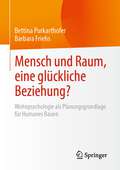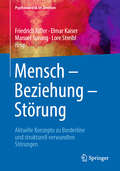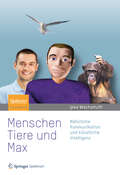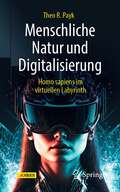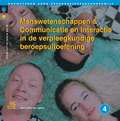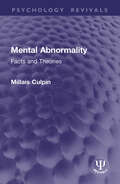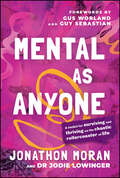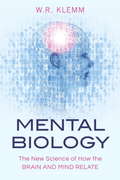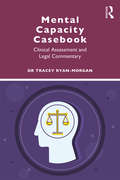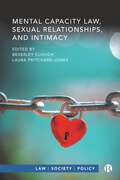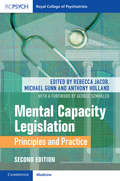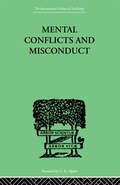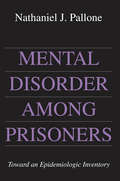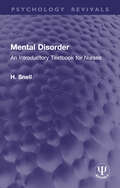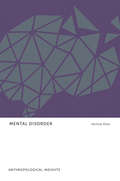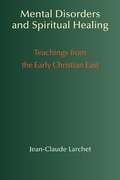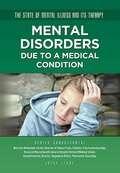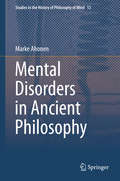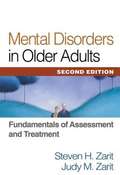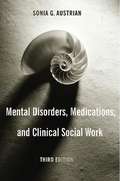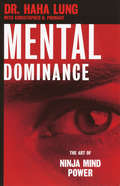- Table View
- List View
Mensch und KI in Organisationen: Einfluss und Umsetzung Künstlicher Intelligenz in wirtschaftspsychologischen Anwendungsfeldern
by Melanie HasenbeinDieses Buch "Mensch und KI in Organisationen" zeigt Ihnen auf, welchen Einfluss die Künstliche Intelligenz und Robotik auf den Menschen in der aktuellen und zukünftigen Arbeits- und Organisationswelt hat. Das Werk nimmt Sie mit auf die Reise der Künstlichen Intelligenz in einzelnen psychologischen und wirtschaftspsychologischen Anwendungsfeldern.Auf der Basis von theoretischem Hintergrundwissen und aktuellen Studien sowie praktischen Umsetzungsmöglichkeiten erfahren Sie:wie Künstliche Intelligenz die Arbeits- und Organisationswelt verändert,was eine Mensch-KI-Interaktion und Mensch-Roboter-Interaktion kennzeichnet,wo KI und Roboter im Human-Resources-Bereich eingesetzt werden,welche zukünftigen Lernszenarien mit KI und Robotern möglich sind,wie eine hybride Führung und Teamarbeit zwischen Mensch, KI und Robotern aussehen kann und welche ethischen Grundsätze beim Einsatz von KI und Robotern zu berücksichtigen sind. Das Buch ist angereichert mit digitalen Fragen und Antworten, die Sie über die Flashcard App zum Selbsttest nutzen können. Die ZielgruppenProfessionals im Organisations- und Personalbereich, Berater, Trainer und CoachesStudierende der Wirtschaftspsychologie sowie der Angewandten und Digitalen Psychologie
Mensch und Raum, eine glückliche Beziehung?: Wohnpsychologie als Planungsgrundlage für Humanes Bauen
by Barbara Friehs Bettina PurkarthoferDas Buch bietet einen umfassenden Überblick über die Mensch-Umwelt-Beziehungen und betrachtet sowohl Wohnen aus systemischer Sicht als auch die lebensraumbezogenen Wohnbedürfnisse.Je hektischer und instabiler der Alltag bzw. die Außenwelt, desto wichtiger wird ein Zuhause, das Regeneration erlaubt, das Sicherheit und Geborgenheit schenkt. Ein Zuhause, das nicht nur den individuellen Wohnwünschen und -anforderungen entspricht, sondern auch die (oft unbewussten) grundlegenden menschlichen Wohnbedürfnisse wie etwa nach Privatheit, sensorischer Wahrnehmung, Selbstbestimmung und Regulation, Aneignung, Ortsbindung, Entwicklung und Entfaltung (…) erfüllt.Davon ausgehend, dass jeder (natürliche und gebaute) Raum unser Empfinden, Denken, Verhalten und Zusammenleben beeinflusst, führt der Weg zu „Humanen Lebensräumen“ über die Betrachtung von Wohnung, Wohngebäude bzw. Wohnumfeld hinsichtlich der wechselseitigen Wirkung "Mensch – Raum" aber auch über die Bewusstseinsschärfung der Bewohner für die eigenen Wohnbedürfnisse und jene der Mitbewohnenden.
Mensch – Beziehung – Störung: Aktuelle Konzepte zu Borderline und strukturell verwandten Störungen (Psychosomatik im Zentrum #3)
by Friedrich Riffer Elmar Kaiser Manuel Sprung Lore StreiblDer dritte Band der Buchreihe des Psychosomatischen Zentrums Waldviertel (PSZW), Universitätsklinik für Psychosomatische Medizin der Karl Landsteiner Privatuniversität, beschäftigt sich mit Borderline und strukturell verwandten Störungen aus verschiedenen Blickwinkeln. Michael Köhlmeier eröffnet mit einem Gastbeitrag über die Fachgrenzen hinweg anhand von Märchen über Liebe und Aggression, zwei wichtigen Schlüsselelementen für das Verständnis der Borderlinestörung. In den anschließenden fachspezifischen Beiträgen wird ein Überblick über aktuelle Konzepte zur Ätiologie, Pathogenese und Therapie von Menschen mit Borderline und strukturell verwandten Störungen gegeben. Des Weiteren werden neueste Aspekte und Erkenntnisse zu genetischen und neurobiologischen Grundlagen dieser Störung vorgestellt. Der Konnex bzw. die Schwierigkeit der Abgrenzung zu Traumafolgestörungen wird ebenso diskutiert, wie die Beziehungsgestaltung von Menschen mit Borderlinestörung und der Umgang mit Kränkung und Gegenübertragung. Das Panorama ist der Rolle von Akzeptanz in der Therapie von Menschen mit chronischen Schmerzen gewidmet. Dieses Buch richtet sich in erster Linie an Ärzte, Psychotherapeuten, Klinische- und Gesundheitspsychologen sowie verwandte Berufsgruppen, die Patienten mit Borderline- oder strukturell verwandten Störungen behandeln.
Menschen stärken: Resilienzförderung in verschiedenen Lebensbereichen (Studien zur Resilienzforschung)
by Klaus Fröhlich-Gildhoff Maike Rönnau-BöseMit diesem Buch werden Möglichkeiten der Resilienzförderung, allgemeiner: der Förderung der seelischen Gesundheit, in verschiedenen Lebensbereichen beschrieben. Neben konkreten Erfahrungen in Fördermaßnahmen stehen wissenschaftliche Grundlagen im Vordergrund, um systematisch eine ganzheitliche Perspektive zur Resilienzförderung in verschiedenen Lebenssituationen und -abschnitten zu entwickeln. Die Autor*Innen schöpfen dabei insbesondere aus Erfahrungen in Projekten am Zentrum für Kinder- und Jugendforschung der Evangelischen Hochschule in Freiburg.
Menschen, Tiere und Max
by Ipke Wachsmuth"Nur selten fragt die Wissenschaft nach dem roten Faden, der Lebendiges mit Technischem, Mensch mit Tier und beide mit Computern oder Robotern verbindet. Dieses lesenswerte Buch ist ein brillanter Führer durch den Themendschungel - und unerlässlich für jeden, der sich über den Stand der Forschung informieren will." Gert Scobel, 3sat"Was ist Kommunikation? Ein Pionier des digitalen Zeitalters nimmt uns mit auf eine spannende Reise: von Menschen und Tieren zu Computern und Robotern, die uns zunehmend ähneln und zugleich verändern und in Frage stellen. Wer sind wir, und wie werden wir künftig miteinander umgehen? Zugleich augenzwinkernd und tiefgründig und vor allem immer authentisch baut Ipke Wachsmuth beim Leser nicht nur Unwissen ab, sondern auch Ängste und Sorgen." Manfred Spitzer, Autor von "Lernen" und "Medizin für die Bildung"Wie gelingt Kommunikation? Unter welchen Voraussetzungen verstehen wir einander? Wie lernen Kleinkinder, sich zu verständigen? Wie kommunizieren Tiere untereinander und mit uns? Und schließlich: Können Roboter und virtuelle Agenten zu vertrauenswürdigen und einfühlsamen Dialogpartnern und Helfern werden? Ipke Wachsmuth führt den Leser auf einen spannenden Streifzug durch die Vielfalt und Komplexität der kommunikativen Fähigkeiten. Immer wieder begegnet uns dabei Max, ein Kunstmensch aus der virtuellen Realität, an dem sich ganz konkret das Funktionieren von Kommunikation und Fragen über die Möglichkeiten künstlicher Intelligenz erörtern lassen. Aus dem Epilog: Ich erwache, weil Max mich ruft. Von der schimmernden Wand, die ein einziges riesiges Display ist und die hinter ihm nun das Tagespanorama von Seoul zeigt, begrüßt er mich mit fröhlichem Gesicht: "Guten Morgen, Ipke, acht Uhr! Ausgeschlafen? Du hast doch um zehn Uhr einen Termin." ... Jetzt aber los. Halt, wie war das noch mit der freundlichen Begrüßung? "Max? Wie sagt man nochmal ,Guten Tag' in Korea?" Max sogleich: "An-nyeong ha-se-yo", und weiter: "Du musst in einer Viertelstunde aufbrechen." Also doch noch Zeit für ein wenig Entspannung. "Max, gib mal etwas Musik." Er kennt ja meine Lieblingsstücke, aus meinem iTunes. Max wählt ein Bluesstück aus und tanzt dazu. Ich greife zum Couchtisch, wo meine Bluesharp liegt, und jamme etwas, variiere das eine oder andere, bis es richtig groovt. _____ Möwen, Krabben und Marktschreier - ausgehend von Alltagsbeobachtungen beleuchtet Ipke Wachsmuth in diesem Buch die Themen Kommunikation, natürliche und künstliche Intelligenz. Es geht dabei um Sprache und Denken, um Mimik und Gestik - und um die Komplexität hinter den so alltäglich erscheinenden kommunikativen Fähigkeiten von Menschen und Tieren. Das Buch führt auch in die Welt von Robotern und anderen künstlichen Wesen ein, die unseren künftigen Alltag mehr und mehr bevölkern werden. Max ist ein "lebendes" Beispiel dafür, wie die Schnittstelle zwischen Mensch und Computer in Zukunft aussehen könnte. Doch wie erzeugt man ausdrucksvolle Sprache? Wie lassen sich Gesichtsausdrücke technisch nachahmen? Welche Rolle spielt der Sprechrhythmus für unsere Kommunikation? Wie ist die hochentwickelte Wortsprache des Menschen entstanden, die uns von allen Tieren unterscheidet? Bildgebende Verfahren machen es heute möglich, dem Hirn beim Denken "zuzuschauen" und damit auch Einblicke in die Prozesse des Sprachverstehens zu erlangen, die man mit künstlicher Intelligenz nachzuahmen versucht. Zu den weiteren Themen des Buches gehören Gebärdensprachen, der Zusammenhang von Zeichen und Bedeutung sowie die Wirkung von spontanen Körperbewegungen und Körperhaltung für die Übermittlung von Botschaften. Spannend ist die Frage, inwieweit Tiere und Menschen sich über Bedeutsames austauschen können. Sind Menschenaffen in der Lage, Symbole zu gebrauchen und absichtsvoll zu kommunizieren, verfügen sie vielleicht sogar über Bewusstsein? Und wird sich ein Maschinenwesen wie Max eines Tages mit uns aus der Perspektive eines eigenen "Ich" unterhalten können? Maschinen mit "Eigenleben" - kann es und soll es die geben? Könnten sie einfühlsame Partner des Menschen werden...
Menschliche Natur und Digitalisierung: Homo sapiens im digitalen Labyrinth
by Theo R. PaykDer Text widmet sich den Folgen einer sinnlich-sensorischen und spirituellen Verarmung samt Verlust an kommunikativer Kompetenz und Solidarität infolge einer digitalen Überflutung. Dennoch wäre es ebenso kontraproduktiv wie erfolglos, die allgegenwärtige Digitalisierung zu dämonisieren; sinnvoll wären indes präventiv-salutogenetische Maßnahmen sowie Regeln zum Schutz der menschlichen Natur, vor allem im Hinblick auf eine Überschreitung der Gehirn-Maschine-Grenze.
Menschliches Verhalten im Wandel der Zeit: Konstanz und Veränderung der menschlichen Psyche
by Martin SchusterMenschen unterschieden sich, von Kultur zu Kultur, von Gesellschaft zu Gesellschaft, von Individuum zu Individuum. Aber Menschen unterscheiden sich auch von einer Epoche zur anderen - im Verlauf der Zeit. Zu verschiedenen Zeiten lassen sich unterschiedliche Verhaltensstile identifizieren und beschreiben, die Folge und Ursache menschlichen Verhaltens im Laufe der Zeit waren und sind und unsere Geschichte geprägt haben.Dieses Sachbuch stellt der kulturvergleichenden Psychologie die zeiten- oder epochenvergleichende Psychologie zur Seite, und zeigt anhand zahlreicher illustrer Beispiele und dramatischer Ereignisse aus der Geschichte auf, wie sich Verhaltensstile entwickeln, wie sie sich verändern oder die Zeiten überdauern. Die Beispiele stammen aus den Themenkomplexen Gesundheit, Emotionen, (liebevolle) Beziehungen und Sexualität, Selbst und Identität, Denken, mentale Fertigkeiten und Kreativität.
Menswetenschappen & communicatie en interactie in de verpleegkundige beroepsuitoefening
by Hilde De Vocht J.H.J. de JongIn dit boek wordt ingegaan op psychologie, sociologie, antropologie, filosofie en agogiek, zodat een compleet boekwerk voor de menswetenschappen ontstaat. Het boek kent drie delen: theorie, toepassing in de beroepsuitoefening, toepassing bij specifieke zorgcategorieen
Mental Abnormality: Facts and Theories (Psychology Revivals)
by Millais CulpinFirst published in 1948, Mental Abnormality: Facts and Theories was written when great changes were taking place in the handling of mental disorders and in the teaching of the subject in medical schools. Knowledge of this progress reached the public in a scrappy and sometimes misleading form, and the author felt that people had as much right to know about it as about advances in the more physical side of medicine. This book gives an outline of the many and often unsuspected ways in which so called ‘mental abnormality’ could manifest itself, together with an account of developments both in theory and treatment at the time. Today it can be read in its historical context.This book is a re-issue originally published in 1948. The language used and views portrayed are a reflection of its era and no offence is meant by the Publishers to any reader by this re-publication.
Mental As Anyone: A Toolkit for Surviving and Thriving on the Chaotic Rollercoaster of Life
by Jonathon Moran Dr Jodie LowingerLessons in mental health and life from acclaimed entertainment journalist Jonathon Moran Mental health issues can affect everyone, so it's crucial that you have strategies to help you combat life's ups and downs as they happen. Mental as Anyone is a brutally honest self-help book for anyone dealing with the challenges of mental health. Shared through his own personal story, journalist and host of the Mental as Anyone podcast Jonathon ‘JMo’ Moran, with the help of expert clinical psychologist Dr Jodie Lowinger, offers real-life coping strategies to break down the barrier to mental health literacy. Developed through experiencing his own trauma, Moran shares through personal stories how he built his life tool kit and, backed with strategies from Dr Lowinger, shows how you can build your own, with practical coping methods that you can implement immediately to improve your mental health. With these comprehensive mental wellness tools and techniques, you'll have the support you need for issues related to sexuality, depression, addictive substances and behaviours, self-esteem, loss and abuse. Inside the book: Actionable advice for your “life tool kit” to help you face life's inevitable challenges Extraordinary stories from Moran's personal and professional life — from meeting Madonna to spending an evening in Carrie Fisher's hotel room Universally applicable self-help strategies learned from personal experiences and professional practice, and grounded in psychology Perfect for anyone interested in becoming the best version of themselves, Mental As Anyone is a timely and personal reminder that life can be a struggle, but we all have it within ourselves to overcome the obstacles life throws at us.
Mental Biology
by W. R. KlemmA leading neuroscientist offers the latest research and many new ideas on the connections between brain circuitry and conscious experience.How the mysterious three-pound organ in our heads creates the rich array of human mental experience, including the sense of self and consciousness, is one of the great challenges of 21st-century science. Veteran neuroscientist W. R. Klemm presents the latest research findings on this elusive brain-mind connection in a lucidly presented, accessible, and engaging narrative. The author focuses on how mind emerges from nerve-impulse patterns in the densely-packed neural circuits that make up most of the brain, suggesting that conscious mind can be viewed as a sort of neural-activity-based avatar. As an entity in its own right, mind on the conscious level can have significant independent action, shaping the brain that sustains it through its plans, goals, interests, and interactions with the world. Thus, in a very literal sense, we become what we think.Against researchers who argue that conscious mind is merely a passive observer and free will an illusion, the author presents evidence showing that mental creativity, freedom to act, and personal responsibility are very real. He also delves into the role of dream sleep in both animals and humans, and explains the brain-based differences between nonconscious, unconscious, and conscious minds.Written in a jargon-free style understandable to the lay reader, this is a fascinating synthesis of recent neuroscience and intriguing hypotheses.
Mental Capacity Casebook: Clinical Assessment and Legal Commentary
by Tracey Ryan-MorganThe Mental Capacity Act 2005 (MCA) provides a legal framework for acting on behalf of individuals who lack the capacity to make decisions for themselves. The Mental Capacity Casebook showcases numerous real-life case studies in accordance to this Act. Through the exploration of various mental capacity assessments, this book highlights the psychological needs of the individuals who are supported and protected by the MCA. Dr. Tracey Ryan-Morgan, a Consultant Clinical Neuropsychologist, is the first to bridge the gap between the individual’s psychological requirements and the legal framework surrounding them. Not only does this book present true, often complex, mental capacity assessments, it does so with legitimate corresponding commentaries. Each case outlines the presented problem along with its background, social context, psychological matters, the overriding opinion and concluding learning points. This book provides a unique standpoint, offering insight into the complexities of the Act and practical guidance on how to conduct assessments. It serves as essential reading for those looking for guidance whilst making complex capacity decisions, such as Clinical Neuropsychologists, Social Workers, and Legal Professionals.
Mental Capacity Law, Sexual Relationships, and Intimacy (Law, Society, Policy)
by Karen Brennan Andrea Hollomotz Alex Ruck Keene Hannah Morgan Ralph Sandland Claire Bates Neil Allen Jaime Lindsey Allegra Enefer Alan Cusack Becky Squires Oluwatoyin Sorinmade Carmelle Peisah Lorraine CurrieQuestions as to the mental capacity of an individual to consent to sex are an increasingly important aspect of legal scholarship and professional practice for those working in care. Recent case law has added new layers of complexity, requiring that a person must be able to understand that the other person needs to consent and can withdraw that consent. While this has been welcomed for asserting the importance of the interpersonal dynamics of sex, it has significant implications for practice and for the day-to-day lives of people with cognitive impairments. This collection brings together academics, practitioners and organizations to consider the challenges posed by the current legal framework, and future directions for law, policy and practice.
Mental Capacity Legislation: Principles and Practice
by Rebecca Jacob Michael Gunn Anthony HollandCrucial to health and social care practice, the Mental Capacity Act (MCA) 2005 safeguards decision-making within a legal framework. This book provides theoretical, practical and up-to-date guidance on mental capacity legislation. It focuses on the theory underpinning the principles of the MCA 2005, including historical background, and the practical challenges in applying legal statute in varied clinical settings, from hospitals to social care in community settings. Recent case law is detailed and examples of ethical dilemmas and medico-legal challenges feature, along with guidance to navigate these in clinical practice. Applying mental capacity principles in end-of-life decision-making is an area of discussion, as well as the future of legislative changes in the field. To be read alongside the MCA 2005 Code of Practice, this guide will support mental health and social care professionals in clinical settings.
Mental Conflicts And Misconduct
by Healy, WilliamFirst published in 1999. Routledge is an imprint of Taylor & Francis, an informa company.
Mental Disorder Among Prisoners: Toward an Epidemiologic Inventory
by Nathaniel PalloneWhat do we know about the mental health of inmates? What are the implications of what we know? Nathaniel J. Pallone characterizes opinion on these questions as falling into two broad camps: the "tender-hearted," those who see an overlap between mental illness and criminal behavior, and are treatment-oriented; and the "tough-minded," those who have little confidence in psychiatric categories, do not really accept arguments about diminished responsibility, and who feel the emphasis should be on punishment. Which is closer to the truth?When this book was first published, the incidence of mental disorder among prisoners was nearly four times greater than among comparable groups in the general population in part because prisoners are disproportionately drawn from demographic groups with a high incidence of mental disorder—nonwhite and from lower socioeconomic strata. But other data is equally dismaying: mental retardation is 50 percent higher; alcohol and drug abuse is between five and eight times greater; and neurogenic disorders may be 1,700 times greater. In all categories of mental illness, the incidence among prisoners is far higher than among the general population.Pallone asserts that evidence suggests that the design and implementation of mental health care needs serious reevaluation, particularly in view of Supreme Court decisions mandating mental health care despite obstacles with implementation. Palone saw mental health care as the primary issue for those who manage prisons. Sadly, this remains as true as when this book was first published.
Mental Disorder in Canada
by David L. Streiner John CairneyCanada has long been recognized as a leader in the field of psychiatric epidemiology, the study of the factors affecting mental health in populations. However, there has never been a book dedicated to the study of mental disorder at a population level in Canada. This collection of essays by leading scholars in the discipline uses data from the country's first national survey of mental disorder, the Canadian Community Health Survey of 2005, to fill that gap.Mental Disorder in Canada explores the history of psychiatric epidemiology, evaluates methodological issues, and analyzes the prevalence of several significant mental disorders in the population. The collection also includes essays on stigma, mental disorder and the criminal justice system, and mental health among women, children, workers, and other demographic groups. Focusing specifically on Canadian scholarship, yet wide-reaching in scope, Mental Disorder in Canada is an important contribution to the dissemination and advancement of knowledge on psychiatric epidemiology.
Mental Disorder: An Introductory Textbook for Nurses (Psychology Revivals)
by H. SnellOriginally published in 1977, this book was written in response to demands for a textbook of psychiatry which was neither too theoretical, nor so simple that it was inaccurate. It was addressed primarily to pupil nurses in hospitals for the mentally ill, and to student nurses in their first months of training. Its style and content ensured that it could be read with profit by all others whose work brought them into close contact with the mentally ill.The early chapters provide a history of care and treatment, an introduction to psychological development and the unconscious mind, and an explanation of mental disorder and its causes. Specific mental disorders are discussed together with an outline of their treatments, and the general management of the patient is described wherever appropriate. Case illustrations are given as specific examples of various mental conditions. The final chapters cover modern psychological and physical treatments, the aims and means of rehabilitation, and the resources available for the care of the patient in the community. Today it can be read in its historical context.This book is a re-issue originally published in 1977. The language used is a reflection of its era and no offence is meant by the Publishers to any reader by this re-publication.
Mental Disorder: Anthropological Insights
by Nichola KhanThis brief book introduces the ways in which contemporary anthropology engages with the "psych" disciplines: psychology, psychiatry, and medicine. Khan also widens the conversation by including the perspectives of epidemiologists, addiction and legal experts, journalists, filmmakers, activists, patients, and sufferers. New approaches to mental illness are situated in the context of historical, political, psychoanalytic, and postcolonial frameworks, allowing readers to understand how health, illness, normality, and abnormality are constructed and produced. Using case studies from a variety of regions, Khan explores what anthropologically informed psychology, psychiatry, and medicine can tell us about mental illness across cultures.
Mental Disorders And Spiritual Healing: Teachings From The Early Christian East
by Jean-Claude LarchetThis work, the third panel of a triptych dedicated by the author to the notion of illness derived from the patristic and hagiographic texts of the Christian East from the first to the fourteenth centuries, makes an essential contribution to the history of mental illnesses and their therapies in a domain very little studied until now. Confronted by the numerous problems still posed today in understanding these illnesses, their treatment, and their relationship to those who are sick, he shows the importance offered for reflection and current practice by early Christian thought and experience. <p><p> After indicating how the Fathers understood the psyche and its relationship with body and spirit, the author gives a detailed analysis of the different causes they attribute to mental illness and the various treatments recommended. At the same time he shows how, relying on fundamental Christian values, they manifest a constant solicitude and respect for the sick, and how they are at pains to integrate them into community life and have them participate in their own healing, foreshadowing in this way the needs and aspirations of our own time. <p> The last part discloses the deep significance of one of the strangest and most fascinating forms of asceticism the Christian East has known: 'folly for the sake of Christ', a madness feigned with the goal of attaining a high degree of humility, but also a way well-suited, through a close experience of their condition, to help those who are often among, today as in the past, the most destitute.
Mental Disorders Due to a Medical Condition (The State of Mental Illness and Its Ther #19)
by Joyce LibalJeff's family and friends described him as "good-looking," "fun-loving," "quick-witted," and "talented." He was kind, friendly, ambitious and always succeeded at every task he undertook. No one was surprised when Jeff was selected to represent his school in an international exchange program. But when Jeff returned to Ridgemont High a year later, everyone was shocked at his change in behavior. Why was Jeff so angry and out of control? Could it have something to do with his health? Many medical conditions have serious psychological components and effects. Sometimes, a medical condition in the body can lead to medical disorders of the mind. These are called mental disorders due to a medical condition. Adolescents are among those who suffer from medical conditions, and they are not immune to the accompanying psychological issues that may be involved. But mental disorders caused by medical conditions bring additional challenges to adolescents. Everyday care, management, regulating medication, and the emotional ramifications of medical conditions can be difficult for anyone. Attempting to balance these challenges while maintaining schoolwork, jobs, and extra-curricular activities can add to the stress for young people. In this book, you will learn about some medical disorders, the psychological complications that can result, and the treatments available to fight them. Along the way, you will explore the advances in drug treatment for psychological disorders, how such drugs work, and the risks and side effects associated with these treatments. Numerous case studies and stories of young people like Jeff who are coping with mental disorders caused by medical conditions illustrate the realities of these illnesses, while a chapter on alternative treatment adds information about additional treatment options.
Mental Disorders in Ancient Philosophy
by Marke AhonenThis book offers a comprehensive study of the views of ancient philosophers on mental disorders. Relying on the original Greek and Latin textual sources, the author describes and analyses how the ancient philosophers explained mental illness and its symptoms, including hallucinations, delusions, strange fears and inappropriate moods and how they accounted for the respective roles of body and mind in such disorders. Also considered are ethical questions relating to mental illness, approaches to treatment and the position of mentally ill people in societies of the times. The volume opens with a historical overview that examines ancient medical accounts of mental illness, from Hippocrates' famous Sacred Disease to late antiquity medical authors. Separate chapters interpret in detail the writings of Plato, Aristotle, Galen and the Stoics and a final chapter summarises the views of various strains of Scepticism, the Epicurean school and the Middle and Neo-Platonists. Offering an important and useful contribution to the study of ancient philosophy, psychology and medicine. This volume sheds new light on the history of mental illness and presents a new angle on ancient philosophical psychology.
Mental Disorders in Older Adults, Second Edition
by Steven Zarit Judy ZaritIllustrated with abundant clinical material, this book provides essential knowledge and skills for effective mental health practice with older adults. It demonstrates how to evaluate and treat frequently encountered clinical problems in this population, including dementias, mood and anxiety disorders, and paranoid symptoms. Strategies are presented for implementing psychosocial interventions and integrating them with medications. The book also describes insightful approaches for supporting family caregivers and addresses the nuts and bolts of consulting in institutional settings. Combining their expertise as a researcher and an experienced clinician, the authors offer a unique perspective on the challenges facing older adults and how to help them lead more fulfilling and independent lives. Three reproducible forms can also be downloaded and printed in a convenient 8 1/2" x 11" size.
Mental Disorders, Medications, and Clinical Social Work
by Sonia AustrianWritten for social workers by a social worker, Mental Disorders, Medications, and Clinical Social Work discusses the etiology, epidemiology, assessment, and intervention planning for common mental disorders. Looking at disorders from an ecosystems perspective, Austrian goes beyond a linear classification approach and DSM-IV-TR categories and encourages social workers to analyze the internal and external environmental factors that contribute to a disorder's development. Austrian's discussion of effective intervention(s) for a particular client also stresses the importance of working with families in treating disorders.In addition to information on new medications, biochemical data on the causes of disease, and diagnostic tests, the revised third edition discusses therapies such as motivational interviewing, cognitive-behavioral, interpersonal, and dialectic.
Mental Dominance: The Art of Ninja Mind Power
by Lung Dr Haha Prowant Christopher BThe secrets of the ancient Eastern masters are your key to mind control--and victory. Lost to history until now, these Eastern techniques of mental domination, developed and perfected over thousands of years--and through hundreds of secret cadres--are your crucial weapons for ensuring victory, even before landing a blow. As Dr. Haha Lung and Christopher Prowant unlock the seemingly supernatural strategies of Asia's shrouded cultures in their much-praised easy-to-understand language, you'll master long-lost techniques from: India: the extraordinary physical and mental powers of Tantric sex yoga Tibet: the unstoppable methods of sDop sDop, the secret warrior-monks China: the tactics and techniques of manipulation and mayhem of the Lin-Kuei and Mushuh Nanren Vietnam: the mysterious methods of the The Clack Crows, a stealthy, ninjalike branch of the Cao Dai Japan: the strategies of the criminal masters of Japan's underworld for tempting and terrorizing your victim into obeying your every command A word of caution: these are very powerful--and dangerous--secrets. Mental Dominance is for academic study ONLY. Dr. Haha Lung is the author of more than a dozen books on martial arts, including Mind Penetration, Mind Fist, The Nine Halls of Death, Assassin!, Mind Manipulation, Knights of Darkness, Mind Control: The Ancient Art of Psychological Warfare, The Lost Fighting Arts of Vietnam and, with co-author Christopher B. Prowant, Ninja Shadowland.

